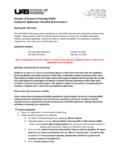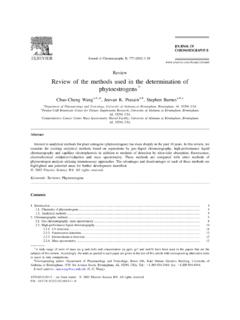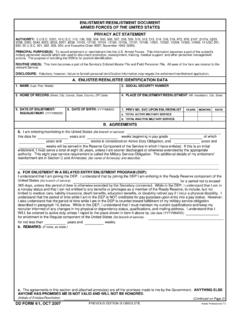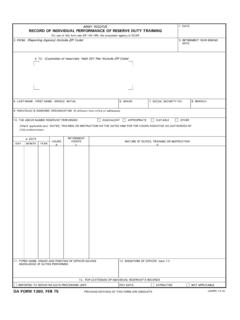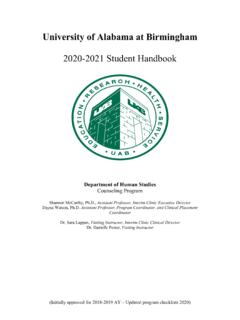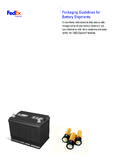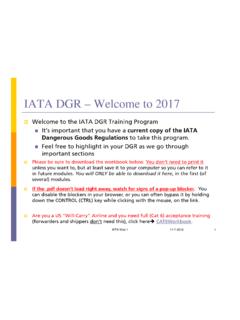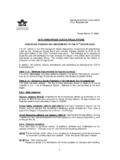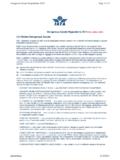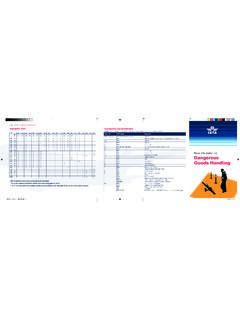Transcription of Shipping Dangerous Goods at UAB
1 Shipping Dangerous Goods at UAB Shipping Dangerous Goods at UAB Page 1 Last Updated: 08/18/2017 Introduction Welcome to the Shipping Dangerous Goods Module. This module is required for anyone that who is mailing shipments of anything deemed a Dangerous good . This training is required every two years or if regulations change significantly. In regards to Shipping , Dangerous Goods are any substance or material capable of posing a risk to health, safety, property, or the environment. UAB requires additional Shipping training for anyone that will be packing: Shipping with Dry Ice (BIO200) Shipping Biological Substances, Category B (BIO201).
2 This includes Genetically Modified Organisms (GMOs) and Exempt Human or Animal Specimens. Shipping Infectious Substances, Category A (BIO202) At the conclusion, participants should be able to: 1. Identify the different International and Federal agencies that dictate policy and procedures for Shipping Dangerous Goods . 2. Prepare a Dangerous Goods shipment correctly according to the Shipper s responsibility. 3. Place the required Marks and Labels on a Dangerous Goods shipment. 4. Fill-out the required documentation that must be with a Dangerous Goods shipment.
3 5. Notify UAB Occupational Health and Safety (OH&S) of any problems when it comes to the Shipping of Dangerous Goods . Objectives This is only the first module of the Shipping training at UAB. Depending on your work, there are other required training. Shipping Dangerous Goods at UAB Shipping Dangerous Goods at UAB Page 2 Last Updated: 08/18/2017 Regulations Federal and International agencies dictate policy and procedures for Shipping Dangerous Goods . The regulations are often specific to the mode of transport ( , air, ground, sea, or railway), classification, or type of hazard.
4 When preparing a shipment, the shipper must use the definitions or classification criteria in the regulations to determine if the material being shipped is a Dangerous good ; either by checking the List of Dangerous Goods for its name (Proper Shipping Name), or determining whether its physical properties/characteristics meet criteria defined in regulations. Shipper Responsibilities The Shipper (or Cosigner) is the person(s) that will prepare the material for shipment and offer it to the operator. For Shipping by air, the International Civil Aviation Organization (ICAO) and the International Air Transportation Association (IATA) dictate the training regulations.
5 Retraining must take place within 24 months of any Shipping activity, or earlier if regulations change. UAB offers training for shipment of Dangerous Goods . Anyone who handles, offers for transport, or transports Dangerous Goods must be trained and certified in three areas: 1. General Awareness/Familiarization Training: This provides a general awareness of Dangerous Goods regulations and enables employees to identify these materials in a manner consistent with hazard communication standards. 2. Function-Specific Training: This training applies to a specific task, such as preparing packages for shipment.
6 Failure to properly pack and ship these materials is a violation of the law punishable with fines and/or imprisonment. Training Shipping Dangerous Goods at UAB Shipping Dangerous Goods at UAB Page 3 Last Updated: 08/18/2017 3. Safety Training: This section covers instructions on the hazards, safe handling, and emergency response procedures associated with Dangerous Goods . The content of this module satisfies the general awareness training requirement. The second and third area are covered in other courses. Depending on what is being shipped, there may be other required training (Chemical Safety, Category A, or Category B.)
7 , etc.). This indicates the type of hazard, not the degree of danger. Class 1: Explosives (6 Divisions) Class 2: Gases (3 Divisions) Class 3: Flammable Liquid Class 4: Flammable Solids (3 Divisions) Class 5: Oxidizing Substances and Organic Peroxides (2 Divisions) Class 6: Toxic and Infectious Substances o Division : Toxic Substances o Division : Infectious Substances Class 7: Radioactive Material Class 8: Corrosives Class 9: Miscellaneous Dangerous Goods (including Dry Ice and Non-Pathogenic Genetically-Modified Organisms) Material to be Shipped Identifying the material to be shipped means selecting the Proper Shipping Name and UN Number from the List of Dangerous Goods .
8 Each Proper Shipping Name is assigned a unique UN Number ( , UN 1845 Dry Ice ). Classification of Dangerous Goods Identifying Shipping Dangerous Goods at UAB Shipping Dangerous Goods at UAB Page 4 Last Updated: 08/18/2017 Packing is defined as the act of placing the Dangerous substances into the appropriate packaging. The required packaging materials and procedures are guided by the Packaging Instructions for the specific Dangerous Goods being shipped. Selecting the Proper Packaging Once the materials intended for shipment are properly classified and identified, regulations dictate the minimum packaging requirements to prevent leakage or spillage during transport.
9 These are referred to as Packaging Instructions and vary depending on the type and quantity of the Dangerous Goods . These are detailed in the IACO Technical Instructions and IATA Dangerous Goods Regulations. For example, Dry Ice is packaged according to Packaging Instructions 954. ) Marks and Labels Marks and Labels communicate to carriers, consignees, and the public about the Dangerous Goods that present in the package. Packages of Dangerous Goods must be durable and clearly visible hazard Marks or Labels that provide information about the contents of the package.
10 Hazard Labels: Diamond-shaped labels that are assigned specific colors or images for easy identification and indicate the class or division of the material in the package. Hazard labels must be accompanied by the Proper UN Number and Proper Shipping Name (PSN) for the associated Dangerous good . Handling Labels: Labels that contain standard colors or images that outline specific handling directions specific to the substances within the package ( , orientation). Packing Shipping Dangerous Goods at UAB Shipping Dangerous Goods at UAB Page 5 Last Updated: 08/18/2017 Documentation There are two types of documents used in transporting Dangerous Goods : 1.
